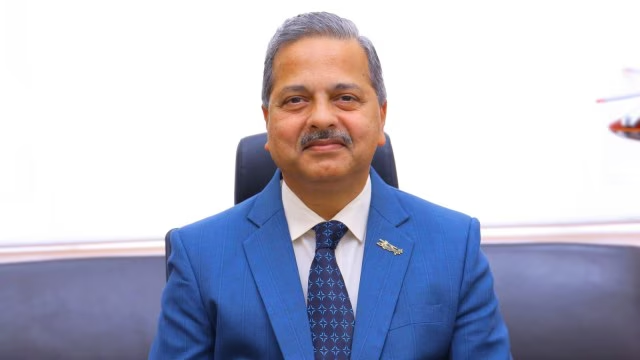Firewall: HAL Chief Confirms US Trade Fights Won’t Scorch India’s Hottest Defense Deal

Image via The Indian Express
BENGALURU – For decades, it has been the holy grail of India’s quest for military self-reliance: the power to design and build the fiery heart of a fighter jet, the engine. After countless setbacks and struggles, that dream is finally on the verge of becoming a reality. In a powerful and exclusive statement, the chief of Hindustan Aeronautics Limited (HAL) has confirmed that the nation’s landmark agreement with America’s General Electric (GE) is secure, protected by a virtual firewall from the turbulent politics of international trade.
C.B. Ananthakrishnan, the Chairman and Managing Director (CMD) of HAL, has put a definitive end to speculation that simmering tariff disputes between New Delhi and Washington could jeopardize the co-production of the state-of-the-art GE F414 jet engine in India. He described the defense partnership as a top-tier strategic priority for both nations, operating on a plane far above the day-to-day friction of commercial trade.
“Let me be absolutely clear: the progress on the F414 engine program is completely independent of any other trade negotiations,” Mr. Ananthakrishnan affirmed. “The strategic alignment between India and the United States, especially in defense and high-technology, has created a robust foundation for this project. It has the full-throated support of the leadership in both countries. We are in constant communication with our partners at GE, and the final commercial negotiations are proceeding smoothly. This deal is happening, and it is a game-changer for India.”
This emphatic reassurance from the very top of India’s aerospace establishment signals that the most significant technology transfer in the nation’s history is not just on track, but is being actively shielded from any external political or economic pressures.
The Everest of Military Technology
To understand the magnitude of this deal, one must first understand why jet engine technology is considered the Mount Everest of military manufacturing. An engine’s core operates under conditions of almost unimaginable stress, with temperatures hot enough to melt the very metals it’s made from and pressures that can turn carbon into diamond. Mastering the exotic metallurgy, the complex aerodynamics, and the precision engineering required to create single-crystal turbine blades and advanced components is a capability fiercely guarded by a tiny club of global powers.
The GE F414 deal effectively gives India a key to enter this exclusive club. The agreement to co-produce these powerful engines in India, which will power the nation’s next-generation Tejas Mk2 and the future AMCA stealth fighter, comes with an unprecedented 80% transfer of technology. This isn’t just a license to assemble parts; it’s a transfer of the knowledge—the very “know-how” and “know-why”—that will allow India to build, maintain, and eventually design its own advanced aero-engines. This move will end India’s critical dependency on foreign suppliers for its fighter jet programs.
The Geopolitical Chessboard
The insulation of this deal from trade disputes is a testament to its immense geopolitical importance. The primary driver for this deep strategic embrace between New Delhi and Washington is the shared challenge of a rising and increasingly assertive China. The United States views a militarily strong and technologically self-reliant India as an essential pillar of a free and open Indo-Pacific.
Therefore, this engine deal is more than just a commercial transaction; it is a strategic investment by the US in India’s defense capabilities. By providing such critical technology, Washington is sending an unmistakable signal that it views India as a top-tier security partner. This partnership, formalized through platforms like the Quadrilateral Security Dialogue (QUAD), is now mature enough to compartmentalize its objectives—allowing strategic defense goals to advance even as the two sides haggle over tariffs on almonds, steel, or Harley-Davidson motorcycles.
Building a National Aerospace Ecosystem
According to the HAL chief, the impact of the deal will ripple far beyond the gates of his company. It is set to catalyze a nationwide revolution in advanced manufacturing.
“This is not just a project for HAL; this is a national project,” Mr. Ananthakrishnan explained. “To build these engines, we will need to cultivate a deep and wide supply chain. We are talking about creating an entire ecosystem of hundreds of micro, small, and medium-sized enterprises (MSMEs) who will specialize in producing high-precision components, advanced materials, and specialized tooling. This will create thousands of high-skilled jobs and spur innovation across the country.”
The road ahead involves the finalization of the commercial contract, followed by the establishment of a new, cutting-edge production facility. Indian engineers will undergo extensive training at GE’s facilities in the US, and a rigorous process of testing and certification will precede the rollout of the first ‘Made in India’ F414 engine, expected within three years of the contract signing.
For India, this marks the end of a long and often frustrating journey as one of the world’s largest importers of arms. The firewall protecting this deal ensures that the nation is firmly on a path to becoming a true aerospace power, capable of building the technology that will secure its skies for generations to come.